Thick-legged
Flower Beetle
Oedemera
nobilis
26
September 2022
A
Devil's Coach-horse Beetle,
Staphylinus
olens, crawled over the tarmac cyclepath
near the Toll Bridge.
4 June 2020
Thick-legged
Flower Beetle
Oedemera
nobilis
1 June 2020
Stag
Beetle ![]()
Sompting
Photograph
by June Bratton
|
9 May 2019 Five small blue-green beetles Psilothrix viridicoerulea were spotted on the flower heads of Sea Campion and Mouse-eared Hawkweed on the Widewater flood plain. |
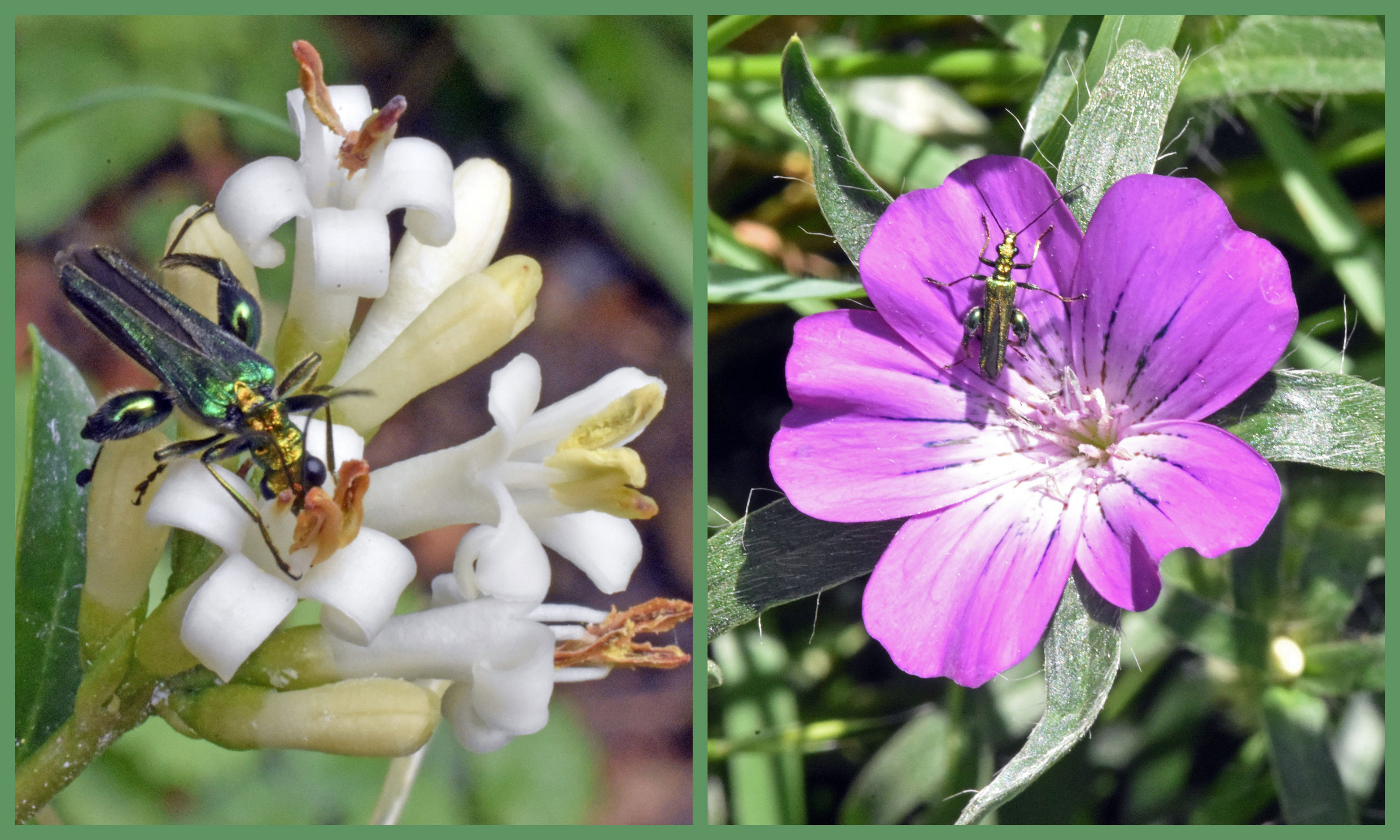 |
16
June 2019
Thick-legged
Flower Beetle
|
.jpg) |
28
April 2019
Wasp Beetle, Clytus arietis, on an Elm leaf, by the footpath by Frampton's Field, at the top of The Street, Old Shoreham. |
19 June 2018
Stag Beetle ![]()
A female
Stag
Beetle flew well over my head in Kingston Lane
from Shoreham to Southwick by a row of Elm trees.
 |
20
August 2017
A female larvaform Drilus flavescens beetle was discovered on the concrete path by the swing gate ta Dacre Garden entrance to Anchor Bottom so altogether it was a very varied hour and half.. |
|
14 June 2017 The most likely species for the green beetle seems to be Cryptocephalus aureolus. Buckingham Cutting (S) |
3 June
2017
Two
small green beetles Psilothrix
viridicoerulea
visited the yellow
centres (=disc) of the Seaside
Daisy. A steady Strong
Breeze (Force
5) off the sea impaired close-up photography
on Shoreham Beach.
 |
16
May 2017
Isomira murina A small 12 mm long beetle on the lower slopes of Mill Hill. |
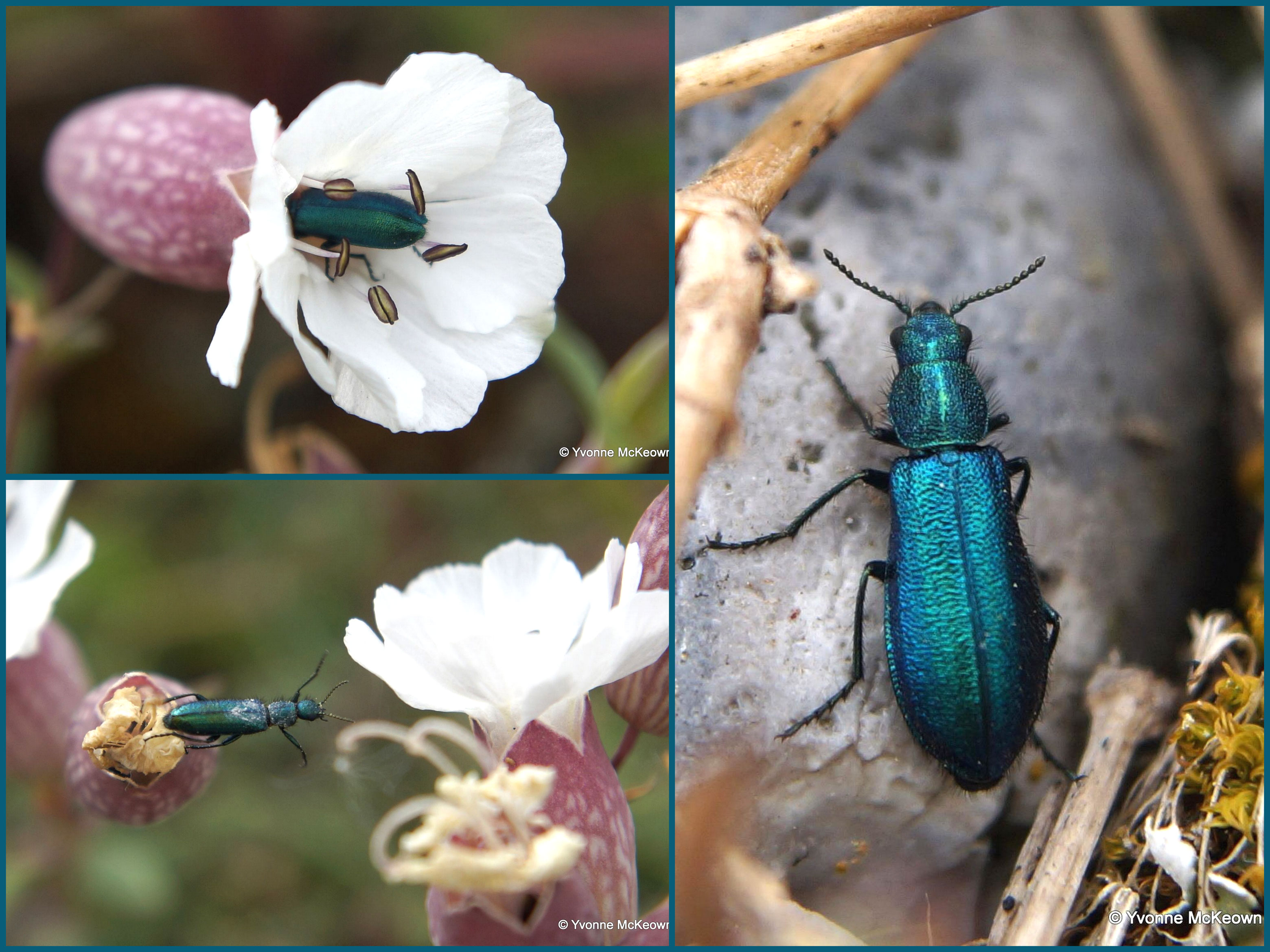 |
7
May 2017
Beetles at Widewater Psilothrix viridicoerulea |
 |
24
September 2016
This black beetle (not Poecilus) crawled across the path through the churchyard of St. Mary de Haura in the middle of Shoreham. This is Pterostichus (either aethiops, or, more probably, the dark-legged form of madidus) ID
by Boris
|
22
September 2016
A
Devil's
Coach Beetle, Staphylinus olens,
crawled across the cyclepath near the Cement Works.
14 August 2016
Spring/Summer 2016
The black ground carabid beetle crawled over a plate in the Car Boot Sale field, north of Old Shoreham. Habitat: damp meadow (during a dry period)
This is Feronia nigrita (Pterostichus n.), a member of the sub-family Harpalinae of the Carabidae or Ground Beetles. It is usually nocturnal, hunting at night for all sorts of invertebrates. Commonly found in woods and gardens. (WRONG)ID & Comments by Tim Rayner facebookOther people (Rik Harris, Boris) have identified it as Poecilus cupreus/versicolor.
NB: Poecilus has keeled antenomeres which you can just see and also first two are light coloured. Feronia nigrita (now called Pterostichus nigrita) has none of these. Poecilus cupreus (Linnaeus, 1758)
Description: 11-13 mm long dull coppery-green predatory ground beetle living in damp meadows.Poecilus versicolor (Sturm, 1824)
Description: 9-12 mm long green or brassy to reddish, often bi-coloured, diurnal ground beetle. Usually found living in dry grassland, (heaths, downland, cliff tops etc.) or bare sandy places.Poecilus Bonelli, 1810
Comparison images
 |
 |
|
Oedemera nobilis |
|
 |
24
June 2016
A small brown beetle was discovered on the lower slopes of Mill Hill to be Omaloplia ruricola. This scarab (chafer beetle) is Nationally Scarce B species and found on calcareous grasslands. TQ 21064 07294. ID
by Stewart Bevan
PS: This looks very much
like but not a Common Cockchafer, Melolontha
melolontha.
The most widely established assessment system for rarity and scarcity is based around presence of species in the hectads of the Ordnance Survey National Grid. Nationally Rare is conventionally defined as species which are found in 15 or fewer hectads. Nationally Scarce (also termed Nationally Notable) relates to species which are found in between 16 and 100 hectads. This category is subdivided into Nationally Scarce (Nationally Notable) A—species found in 16 to 30 hectads, and Nationally Scarce (Nationally Notable) B—species found in between 31 and 100 hectads. A status of Local is also sometimes used, referring to species found in between 101 and 300 hectads. |
 |
25
May 2016
Psilothrix viridicoerulea Shoreham Beach East |
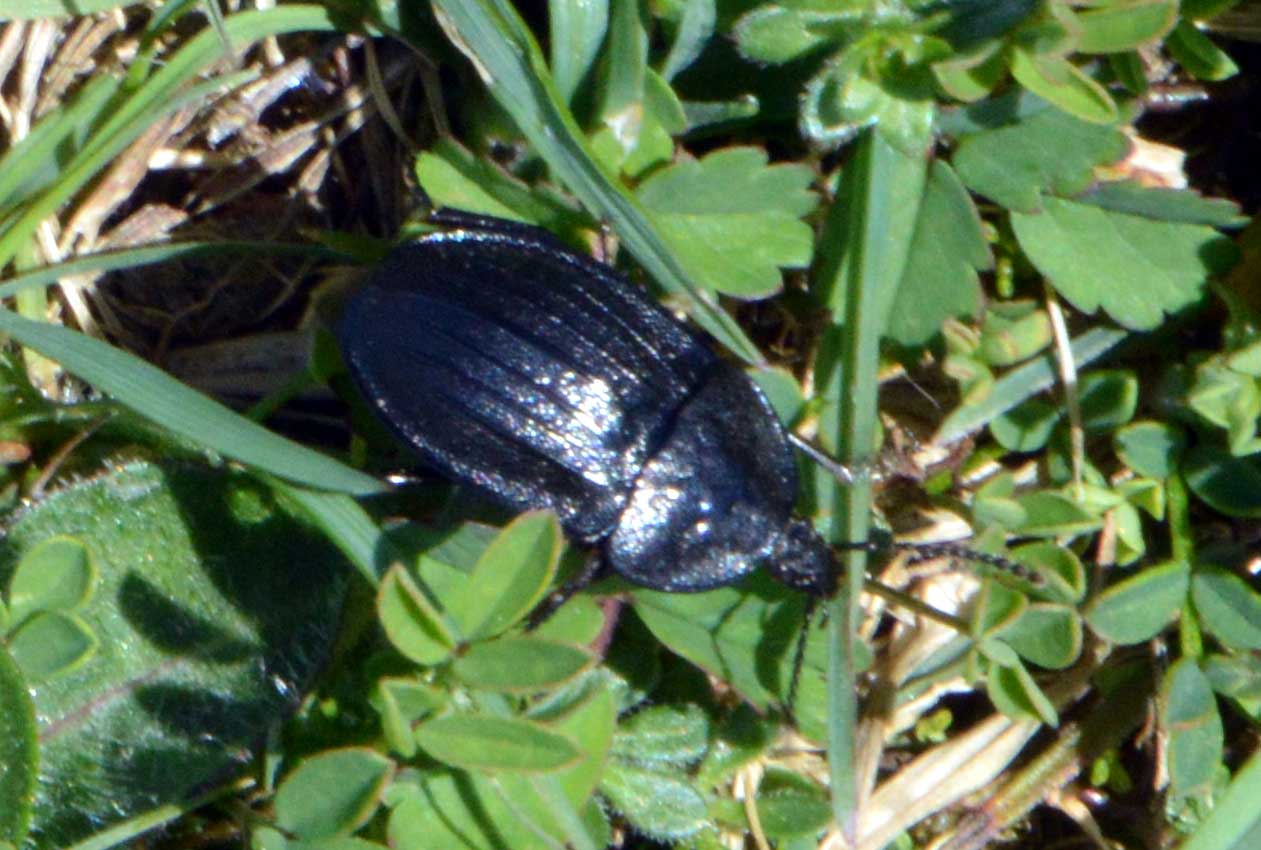 |
20
April 2016
The black ground beetle Silpha atrata crawled rapidly over the short herbs on the lower slopes of Mill Hill in the middle of the afternoon. It is also called Phosphuga atrata and tapered at front end to eat snails. |
| 1
June 2014
After examining a Charlock flowering on Shoreham Beach (on the east verge of the Shoreham Fort car park) I discovered a small green beetle on a Charlock leaf. Although at a distance it looked like a common beetle, a poor quality photograph revealed it to be a almost certainly a beetle from the genus Psilothrix, possibly Psilothrix viridicoerulea, the latter species often common on sand dune beaches on the English Channel coast. 17
April 2014
|
 |
| 30
August 2013
A Bloody-nosed Beetle, Timarcha tenebricosa, was found crawling very slowly over the stony bridlepath in west Steyning, to the south of Mouse Lane on the edge of the forested downs, near some winter cattle pasture. |
 |
4 May
2011
The
small red beetle Rhagonycha
fulva (a Soldier Beetle, Cantharidae)
was seen on Stinging Nettles on the opposite side of the Coombes Road to
the Ladywell's House.
 17
April 2011
17
April 2011
All
of the few Horseshoe Vetch flowers
and occasional Daisies,
on the lower slopes of Mill Hill, were
covered in tiny black pollen beetles Meligethes,
and
the slightly larger shiny green beetle Cryptocephalus crawled
amongst the vegetation.
29
March 2011
On
the lower slopes of Mill
Hill I found a nationally scarce carabid
beetle Licinus depressus
which has specially adapted jaws to feed on snails. It was only 10
mm long.
20
March 2011
I
recorded my first beetle of the year, the very small Paederus
littoralis
seen on a plastic cap on Mill Hill Cutting (south, amongst Ivy leaves next
to the Pixie Path),
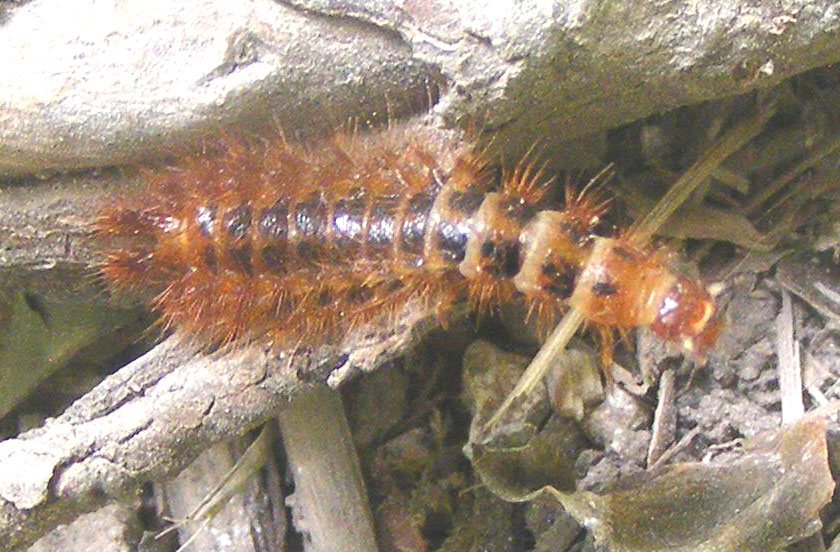 20
July 2010
20
July 2010
A
brown larva of the Drilus beetle
was spotted crawling across a steep path amongst the Hawthorn scrub.
6 September
2009
A
Dor
Beetle
lay dying on the chalk path, south
of the reservoir on the southern part of
Mill
Hill.
Adur
Dor Beetles
 |
8
June 2009
About twenty of the small brown beetles illustrated on the left were flying around in the undergrowth. It could be Lagria hirta. |
 |
7
June 2009
A female Stag Beetle, Lucanus cervus, crawled across the pavement of Buckingham Road, Shoreham, just north of the junction with Nicolson Drive. |
 |
27
May 2009
A male Stag Beetle was rescued from the middle of The Street, Old Shoreham, at the top end next to Frampton's Field and thrown back into the narrow band of Elm trees. |
20
April 2008
On
the lower slopes of Mill
Hill, the first Horseshoe Vetch,
Hippocrepis
comosa, was seen in flower
with the accompanying pollen beetles, Meligethes erichsoni.
Paederus
littoralis
were
seen without looking for them on the path through the scrub in the north-west
of Mill Hill.
| 5
& 10 June 2007
These small green beetles Cryptocephalus and small black pollen beetles Meligethes are commonly seen in spring. The most common plant the black pollen beetles visit is the Hawkbit illustrated on the right. A different species of Meligethes may visit Horseshoe Vetch and another one for Oil Seed Rape. Royal Horticultural Society web page on Pollen Beetles (Meligethes species) |
 |
The
most likely species for the green beetle seems to be Cryptocephalus
aureolus. I have recorded this beetle on Hawkbits,
Bulbous Buttercups, Kidney
Vetch, Pyramidal Orchid
and probably* on Mouse-eared Hawkweed.
All these occurrences are evidenced by photographs. (*Plant
ID is unclear from the photograph.)
Checklist
of UK Recorded Chrysomelidae
|
30
August 2006
 |
A Violet Ground Beetle, Carabus violaceus, hid underneath the discarded chestnut fencing on the Pixie Path.
29
July 2006
A
female Stag Beetle
was flying around in our lounge in Mill Hill Close (south of
Mill
Hill) after darkness. This is number five we have seen. They were surprisingly
nimble in flight but very noisy.
| 18
June 2006
The remains of three Stag Beetles were seen on a woodland path at Lancing Ring. Some predator (experts think of Magpies) must have eaten the juicy bits. The beetle Dascillus cervinus was also discovered. This fawn coloured beetle is a common downland species. Image of Dascillus cervinus Photographs
by Ray Hamblett
on the
Lancing Ring Nature Notes and on flickr British Insects & Other Arthropods |
| 12
June 2006
Thick-legged
Flower Beetle
This is a common and widespread species. |
2 June
2006
A
Devil's
Coach Horse Beetle was seen underneath
the discarded chestnut fencing on the the Pixie
Path.
| 27
May 2006
This little red beetle was spotted on the Sompting Brooks, where the gardens meet the wild strouds. It is only about 6 mm long. Report
&
Photograph
by June Bratton
Identification by Malcolm Storey (BioImages) on the British Insects Yahoo Group |
 |
 |
15
May 2006
A species of Click Beetle (Elateridae) on the lower slopes of Mill Hill. ID by Bill Grange The underneath picture is the insect inverted. Maybe Prosternon
tessellatum (my guess)
Paederus littoralis were still present under the discarded Chestnut fencing on the Pixie Path. |
| 7
May 2006
This small species of bug or beetle (leaf beetle?) was seen in a garden in north Shoreham. It looks like a pest species. This could be Plagiodera versicolora ? |
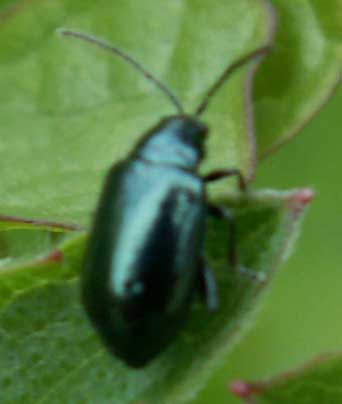 |
9 April
2006
The
beetles Paederus
littoralis
were
still present under the discarded Chestnut fencing on the Pixie
Path.
 18
January 2006
18
January 2006
Under
the discarded Chestnut fencing on the Pixie
Path, most of the dozen wood lice
and a few spiders
scampered off too quickly for the camera. One colourful Rove
Beetle (Staphylinida) was slower and is shown
on the left. There were three or four of these flightless beetles known
as Paederus
littoralis.
The
book (Chinery) says that this beetle is to be
found in damp places. The specific name rather indicates the shore. These
beetles contain a fluid called paederin which can cause the
skin to peel and is more serious if it comes into contact with your eyes.
There are examples of serious
dermatitis caused by this substance (Beetle Juice). The
front of the abdomen is called the elytra.
The identification has not been confirmed, but it seems probable. The British species of the same genus are:
Paederus
caligatus
Erichson, 1840
Paederus
fuscipes Curtis, 1826
Paederus
littoralis
Gravenhorst, 1802
Paederus
riparius (Linnaeus, 1758) The
specific name indicates a river.
This
is a hardy species and one specimen has survived 22 days to 2
March 2006 in an airtight container (35 mm
film capsule) without food or water.
Bumblebees
Hoverflies
Butterflies
Solitary
Bees
Adur
Bees, Wasps & Sawflies
Flies
Water
Beetles
Ladybirds
Moths
Grasshoppers
& Crickets
Damselflies
&
Dragonflies